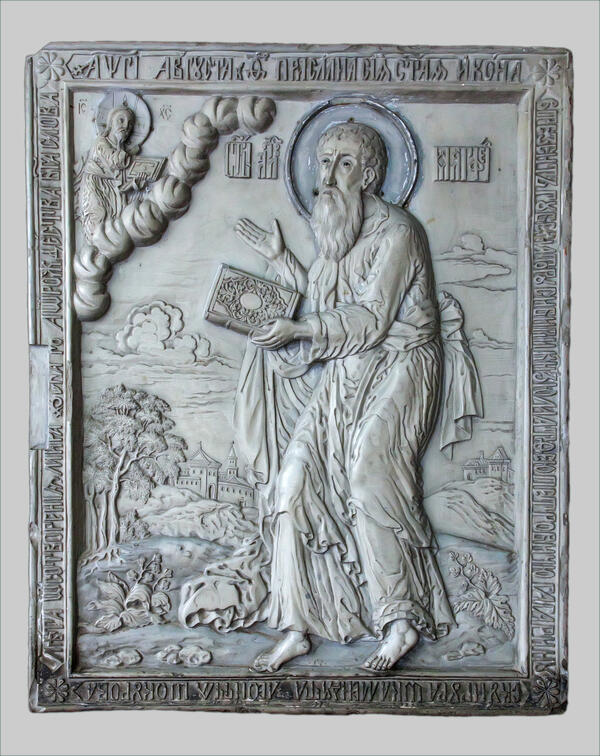The ‘Saint Matthew the Evangelist’ icon, made of smoky jasper, belonged to the first Tobolsk Governor Matvey Gagarin, it depicts his patron saint. The Kungur commandant Levontiy Shokurov presented it to Matvey Gagarin as a gift when the Lord arrived in the territories entrusted to him. This happened approximately in 1709-1713 – this is evidenced by the inscription, which can be seen around the perimeter of the object.
At the turn of the 19th–20th centuries, the Tobolsk Diocesan Brotherhood of St. Great Demetrius of Solunsky, which existed in 1890-1917, began to collect and preserve material monuments of church antiquity. They found them in churches of the Tobolsk diocese or in private households. Later, this direction for the study of church monuments grew to the Church-Archaeological Museum, or the Church’s archives at the sacristy of the St Sophia-Assumption Cathedral in Tobolsk Kremlin. So the icon presented has been put in the archives, and in 1925, when it was disbanded, it was handed over to the funds of the Tobolsk Museum.
On the icon, the Saint Apostle Matthew is depicted standing tall. He is dressed in a long chiton, and his feet are bare. In his left hand, he holds the Gospel closed. In the upper left corner, in the clouds, there is an image of the Lord Jesus Christ blessing.
The Apostle and Evangelist Matthew is the author of one of the four canonical Gospels included in the New Testament, which is considered the earliest. Few facts have been collected about his life. It is known that he lived in Capernaum and was a tax collector, that is, he was in the service of the Roman Empire and profited from his countrymen. Having heard the Christ’s sermon, Levi – the Hebrew name for Matthew – repented, gave away his wealth, and became one of the Savior’s closest disciples. After the ascension of Christ, the Apostle Matthew preached in Palestine, where he wrote the Gospel addressed to its inhabitants in Aramaic, preserved in a later Greek translation. According to legend, he travelled around India, Parthia and Ethiopia and is considered the founder of the Ethiopian Christian Church. He died a martyr in one of the Ethiopian cities.
At the turn of the 19th–20th centuries, the Tobolsk Diocesan Brotherhood of St. Great Demetrius of Solunsky, which existed in 1890-1917, began to collect and preserve material monuments of church antiquity. They found them in churches of the Tobolsk diocese or in private households. Later, this direction for the study of church monuments grew to the Church-Archaeological Museum, or the Church’s archives at the sacristy of the St Sophia-Assumption Cathedral in Tobolsk Kremlin. So the icon presented has been put in the archives, and in 1925, when it was disbanded, it was handed over to the funds of the Tobolsk Museum.
On the icon, the Saint Apostle Matthew is depicted standing tall. He is dressed in a long chiton, and his feet are bare. In his left hand, he holds the Gospel closed. In the upper left corner, in the clouds, there is an image of the Lord Jesus Christ blessing.
The Apostle and Evangelist Matthew is the author of one of the four canonical Gospels included in the New Testament, which is considered the earliest. Few facts have been collected about his life. It is known that he lived in Capernaum and was a tax collector, that is, he was in the service of the Roman Empire and profited from his countrymen. Having heard the Christ’s sermon, Levi – the Hebrew name for Matthew – repented, gave away his wealth, and became one of the Savior’s closest disciples. After the ascension of Christ, the Apostle Matthew preached in Palestine, where he wrote the Gospel addressed to its inhabitants in Aramaic, preserved in a later Greek translation. According to legend, he travelled around India, Parthia and Ethiopia and is considered the founder of the Ethiopian Christian Church. He died a martyr in one of the Ethiopian cities.



